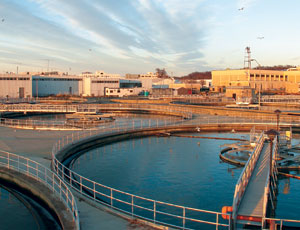Many municipal wastewater systems built in the 1970s and 1980s are nearing the end of their useful lives, forcing municipalities and utilities around the country to look at ways of breathing new life into their treatment plants. The stimulus funding in the $787-billion American Recovery and Reinvestment Act,
coupled with an expected increase in funding for the clean-water and drinking-water state revolving funds (SRFs), could offer some benefit to municipalities that have deferred maintenance and improvement projects because of the troubled economy. But firms that design and build wastewater-treatment facilities say new regulatory requirements—particularly those relating to nutrients—are pushing new projects and technological advancements more than the promise of additional funds.
“The biggest drivers [of new projects] are generally the need for more capacity and regulatory pressures,” says Dave Clark, a senior vice president and director of Omaha-based HDR’s wastewater division. “The need for new capacity slowed with the recession, but that did not change the regulatory pressure for upgrades, and it would appear that a new administration with a new attitude is going to add more pressure on the regulatory side.”
Firms say many of the upgrades taking place are often routine replacements of equipment or parts that no longer function well. Joe Husband, vice president of White Plains, N.Y.-based Malcolm Pirnie Inc., says, “A number of facilities are starting to go back and rehab the facilities that were constructed 20 or 30 years ago.” Although some of the upgrades that have been taking place are routine, he points out that the technologies used are better than those of 30 years ago.
“People are using newer technologies on some of the everyday things you have to do [such as] more efficient aeration devices, whether those are surface aerators or blowers,” he says.
While upgrades have been taking place across the country for some time, almost across the board water professionals say ARRA has been less helpful than expected. “I’m not sure we’ve seen it change owners’ decisions on anything related to deferred maintenance,” says Clark. “The amount of money overall devoted to wastewater projects nationally isn’t that much in comparison to facility needs.”
Glen Daigger, senior wastewater technologist at Englewood, Colo.-based CH2M Hill, says municipalities spend approximately $50 billion a year on maintenance and upgrade projects. The stimulus money, which provided $4 billion for the clean-water state revolving fund and $2 billion for the drinking-water SRF, is a drop in the bucket compared to what’s needed, he says. “The funding source for municipal water and wastewater systems is the ratepayers. That’s where the bulk of the money is coming from, and that’s where the bulk of the money will come from in the future,” he says.
In addition to ARRA, the fiscal 2010 spending bill for the clean-water and drinking-water SRFs also includes a sizable hike in funding. The Senate bill would allocate $2.1 billion for the clean-water SRF; the House bill would allocate $2.3 billion. The fiscal 2009 enacted level was just $689.1 million.
Sources say the stimulus funding has helped municipalities accelerate the schedule for projects already in the pipeline and created incentives for green projects. “We’ve seen a lot of activity in meeting with state representatives on green [projects],” says James Wheeler, senior environmental engineer at the U.S. Environmental Protection Agency.
But many firms point out that the additional funding is not the key driver in the market now. “We don’t see the stimulus or other earmarked funds as being a big driver of new technologies,” says Craig Goehring, CEO of Walnut Creek, Calif.-based Brown and Caldwell. “The main big drivers are the need to look at wastewater as being an integrated resource, the regulatory driver of lower nitrogen and phosphorus limits, [and] the energy recovery side.”
The Nutrient Dilemma
Growing concern about large dead zones in hot spots like the Gulf of Mexico and the Chesapeake Bay—which are caused by excess nitrogen and phosphorus in stormwater and agricultural runoff into tributaries and rivers that drain into large bodies of water—puts states under mounting pressure to develop water-quality standards for nutrients. These stricter requirements are forcing municipalities to plan upgrades to get to lower nutrient limits. “The more-stringent requirements for nitrogen and phosphorus are definitely stimulating innovation and new technologies in treatment,” Goehring says.
EPA developed a national strategy in 1998 that called on states to develop water-quality standards to reduce nitrogen and phosphorus levels from point and non-point sources. But in the 11 years since the agency developed its...





Post a comment to this article
Report Abusive Comment